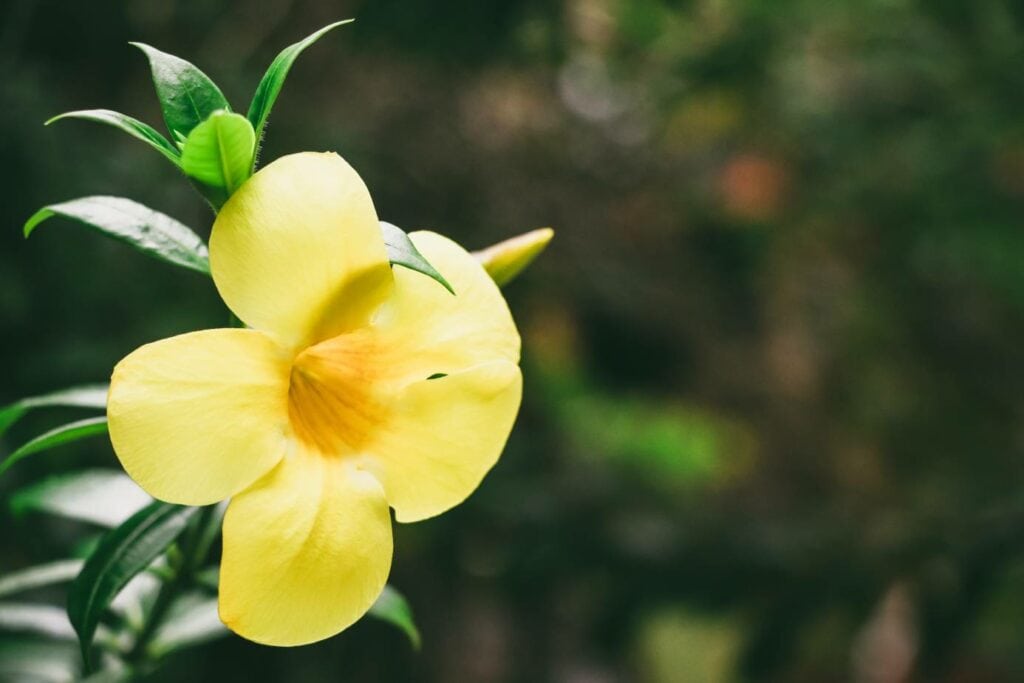What Is the State Flower of South Carolina? History, Facts & FAQ
-

- Last updated:

The yellow jessamine was an easy choice for the South Carolina legislature when they decided on a state flower in 1924. The climbing vine grows across every corner of the state, delighting gardeners with gorgeous yellow blooms heralding spring’s arrival. Let’s explore the origins of the yellow jessamine as South Carolina’s state flower and why gardeners hold it in such high regard.
What Is Yellow Jessamine?
Yellow jessamine goes by several names, including trumpet vine, Carolina jessamine, and the more misleading “yellow jasmine.” Though it looks like some Jasminum varieties, the yellow jessamine is part of the Gelsemium genus.
The yellow-flowering woody plant grows natively in the southern United States from USDA zones 6 through 9. You can find it emerging naturally in fields, along roadsides, and around open forest areas where it crawls up tree trunks.
Yellow jessamine is popular in landscaping schemes as a beautiful high-climbing vine for a trellis, fence, or arbor. It will scale 10–20 feet above the ground in ideal growing conditions. When left to grow without support, it forms a robust mound of vines, making a practical ground cover.
Free from any significant pest or disease problems, the yellow jessamine is an easy vine to train as an ornamental garden feature. The evergreen shines as a delightful decoration throughout the year. Glossy green lanceolate foliage turns bronze in the winter, and bright yellow trumpet-shaped blossoms grow from February through May.
The yellow jessamine’s five-petaled flowers are a multi-sensory delight in the garden. Alongside brilliant displays of springtime color, blossoms also supply a pleasantly sweet aroma.
Yellow Jessamine Toxicity
Although striking, the yellow jessamine is also extremely dangerous. It contains gelsemine and gelseminine, toxic alkaloids common to its genus. The paralytic compounds attack the central nervous system, eventually causing death.
The yellow jessamine’s roots, leaves, and flowers are toxic to humans and animals and potentially lethal if ingested. Simply touching the flowers is often enough to spur an allergic reaction. Exposures are common in children due to the flowers emitting a sweet scent similar to honeysuckles.
Why Is the Yellow Jessamine the State Flower?
The South Carolina General Assembly adopted the yellow jessamine as the official state flower on February 1, 1924. A year prior, the legislative body approved Joint Resolution No. 534, which explained the criteria for choosing the state flower and the committee that would select it.
The widespread yellow jessamine was already a celebrated plant when the state representatives made their designation. South Carolina’s Dixie Chapter No. 395 of the United Daughters of the Confederacy had used the flower as its official emblem since 1906. Anderson local Teresa Strickland, a chapter member, even penned an ode to the yellow flower titled “Legend of the Yellow Jasmine.”
The selection committee considered its importance as a harbinger of spring and extensive distribution throughout the state when choosing the yellow jessamine. The committee’s report detailed the flower’s significance to South Carolina heritage:
“Its fragrance greets us first in the woodland, and its delicate flower suggests the pureness of gold; its perpetual return out of the dead Winter suggests the lesson of constancy in, loyalty to and patriotism in the service of the State.”
The South Carolina state quarter also features the yellow jessamine. You’ll see it sitting on the tails side with two other official state symbols: the sabal palmetto and the Carolina wren.

What Is the State Wildflower?
The yellow jessamine isn’t the only floral representative for South Carolina. Governor Mark Sanford signed the law adopting the goldenrod (Solidago altissima) as the state wildflower on May 14, 2003.
Interestingly, the hardy golden-yellow flower wasn’t the first choice among the garden clubs that made the state wildflower selection. It all started when State Wildflower Chairman for South Carolina’s Garden Club Nancy Odom wanted to generate interest in native flora and gardening. Deciding that the publicity of a state wildflower was a perfect solution, Odom sent a request to over 300 state garden clubs asking for nominations for the state wildflower.
Queen Anne’s lace and goldenrod were neck-and-neck when the votes came in, but because Queen Anne’s lace was technically not a native South Carolina species, goldenrod took the honor. The Senate approved House Bill No. 3233 on April 23, 2003, designating the goldenrod as the titleholder. It became official one month later.
Final Thoughts
One glimpse at a climbing ornamental yellow jessamine, and it’s clear why it’s so prized in South Carolina. Golden flowers signify the start of spring, while glistening evergreen foliage adds a sparkling aesthetic all year long. Touching every corner of the Palmetto State, the yellow jessamine is essential to the state’s character and a worthy choice for the South Carolina state flower.
Featured Image Credit: Kaoalobomo, Shutterstock
Contents

